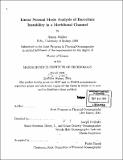Linear normal mode analysis of baroclinic instability in a meridional channel
Author(s)
Walker, Alison (Alison Elizabeth), 1971-
DownloadFull printable version (4.957Mb)
Other Contributors
Massachusetts Institute of Technology. Dept. of Earth, Atmospheric, and Planetary Sciences.
Advisor
Joseph Pedlosky.
Terms of use
Metadata
Show full item recordAbstract
Numerical solutions of the unstable, growing modes are found for the two-layer inviscid quasigeostrophic equations in a meridional channel. A steady mean flow in the N-S direction is imposed in the upper layer, and it is assumed that changes in planetary vorticity following this mean flow are balanced by the input of vorticity from an imposed wind stress curl. Thus in the two-layer system, the vertical shear, in thermal wind balance, is associated with an interface slope which provides a gradient of potential vorticity (PV) in the x-direction, of equal magnitude and opposite sign in the two layers. In the y-direction the PV gradient has the value of planetary beta, [beta], in both layers. The unstable modes of this system exhibit a boundary-layer structure across the channel. They are intensified in the west. The growth rates of the unstable modes are of the same order as the zonal case, however the range of wavenumber and shear for which instability is possible is larger. Established cutoff criteria for the equal-layer zonal case are not applicable, and no analogous criteria has yet been found. Growing modes are found even for very weakly sheared flows, and this suggests that baroclinic instability may represent a more significant source of mid-ocean eddy energy than previously believed.
Description
Thesis (S.M.)--Massachusetts Institute of Technology, Dept. of Earth, Atmospheric, and Planetary Sciences, 2001. Includes bibliographical references (leaves 60-61).
Date issued
2001Department
Massachusetts Institute of Technology. Department of Earth, Atmospheric, and Planetary SciencesPublisher
Massachusetts Institute of Technology
Keywords
Earth, Atmospheric, and Planetary Sciences.